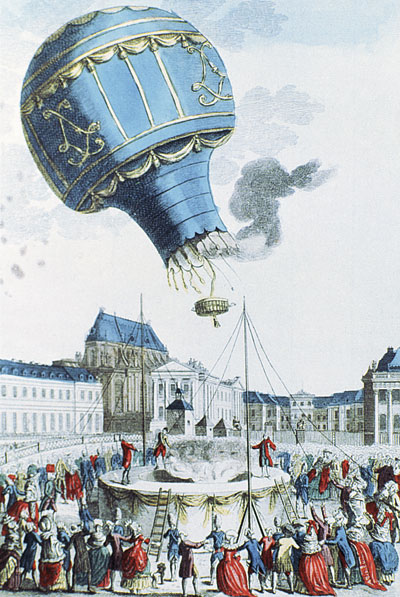‘Caelum certe patet, ibimus illi’ was the phrase blazoned on the side of the Royal Vauxhall, an 80-foot, red and white candy-striped coal gas balloon launched from Vauxhall Pleasure Gardens in 1836 to fly overnight from London to the continent. The motto is from Ovid: ‘Surely the sky lies open, let us go that way!’
It well captures the exuberantly adventurous temper of the early days of ballooning, that gorgeous dead-end in the history of human aviation. Richard Holmes himself caught the ballooning bug in a Norfolk fairground aged four, he tells us, when his RAF pilot uncle fastened a red party balloon to the top button of his aertex shirt. The spirit in which he relates the stories of the pioneer generation of balloon aeronauts is thoroughly informed by love: his sense of ‘the mental release, the physical heart-lift, the calm perilous delight’ that is to be found in the basket of a rising air balloon.
If you were to consult, in the imaginary picture dictionary so useful in school playground disputes, the entry for ‘Class Act’ you would see a picture of Richard Holmes. (The entry for ‘Old Pro’, mystifyingly, depicts a scene involving Wayne Rooney but Holmes’s mugshot should be there too.) This is a book in which the delight the author clearly took in researching and writing it carries over to the reader. So puckish is its pleasure in its details and in its gusts of digression that footnotes — many of them autobiographical or of the ‘thereby hangs a tale’ variety — are marked with a whimsically superscripted icon of a balloon, rather than the usual asterisk. And he has a lovely wit and ease of address.
You had to be pretty brave to go up in one of these things, and the many characters here — from showmen and hucksters to scientists and explorers — all sit on a scale that runs from plucky to outright insane. There are numberless grisly crashes and splats, and melancholy stories of aeronauts last seen drifting out over the edge of the land and off, up into the clouds, never to be seen again. The book concludes with the moving story of a doomed attempt to reach the North Pole by balloon.
We learn of the important technological innovations — such as the ingenious ‘trail rope’, a heavy line which by dragging along the ground helped maintain a constant height (the lower the balloon, the more of the rope’s weight was transferred to the ground, so the lighter the balloon); and the rip panel, allowing fast deflation on landing, so the aeronauts didn’t have to be dragged bumping along the ground for as long as it took the balloon to lose all lift. There are some wonderfully dotty Heath Robinson fixes, too: a patent tempest-prognisticator powered by 12 prize leeches, or a lamp stuffed with glow-worms.
Ballooning, as Holmes’s stories show, has an exceptional range of resonances and points of contact with the coming of modernity. Ballooning, in its early days, participates in science, war, exploration, performance, aesthetic philosophy, propaganda and the history of the commercial publicity stunt. It was an activity that seemed at once to belong to hard science and theology.
It has political implications. It is sometimes co-opted for democracy: Victor Hugo suggested it would liberate mankind from ‘the ancient, universal tyranny of gravity’. (When Félix Nadar, perhaps the greatest ballooning impresario of all time, was presented to Leopold II of Belgium, the King asked him whether he was a republican. He replied: ‘Yes indeed, sire. And you?’ The king responded: ‘Ah! Monsieur Nadar, my profession absolutely forbids it.’) But ballooning is also, at different times, given a national-chauvinist or imperialist colouring.
And the ballooning propaganda stunt — these things being as they are at the mercy of the winds — is always a high-risk activity. There’s a great story of the huge unmanned balloon sent up from Paris in 1804 to celebrate Napoleon’s coronation as Emperor, a whacking great crown suspended beneath it on golden chains. With marvellous and intentional symbolism it crossed the Alps and descended to the imperial city of Rome, until:
The enormous golden crown became hooked on the top of an ancient Roman tomb and broke off, leaving the balloon to disappear, with its banners flapping, over the Pontine marshes. By unbelievable coincidence, or thoroughly appropriate bad luck (you can never tell with balloons), the tomb upon which [the balloon-maker] Garnerin’s prophetic balloon had deposited Napoleon’s golden crown was that of the infamous tyrant and murderous pervert, the Emperor Nero. Napoleon’s name was hooped like a deck-quoit over Nero’s. Once this ill-starred news was efficiently relayed back to Paris by Napoleon’s diplomatic service, Garnerin and his balloons began to fall out of imperial favour.
One of Holmes’s thrilling set-piece chapters describes how, when Paris was utterly encircled by the Prussians, balloons were used to break the blockade and bring thousands of letters to the outside world — replies to which came back on microfilm borne by carrier pigeons. Their propaganda value was immense. When the first of them departed, its pilot dropped handfuls of printed business cards (‘Nadar Photographe’) over the Prussian lines — each of them, reputedly, signed by Nadar and inscribed ‘Compliments to Kaiser Wilhelm and Monsieur von Bismarck.’
Scientific balloonists pioneered the infant science of meteorology, and discovered by terrifying experiment, hands turning black with frostbite, vision blurring, how thin the troposphere — that envelope of air able to sustain life — actually is. Having travelled to the edge of the stratosphere in 1862, the balloonists Glaisher and Coxwell thumped back to earth near Ludlow barely alive, then hiked ‘seven or eight miles’ to the pub for a pint. They not only displayed exceptional grit (or thirst), but their horizontal journey in search of beer was a mile or two further than the vertical distance that nearly killed them. Their six-mile ascent was a record that stood for the rest of the century. And did you know, incidentally, that there are butterflies up there?
In the military sphere, balloons were used to report on enemy troop positions in the American civil war. They allowed gunners accurately to deal death to targets they couldn’t see: ‘an ominous first in the history of warfare, by which destruction could be delivered to a distant and invisible enemy’. The presence of the balloon itself was a psychological weapon. ‘A hawk hovering above a chicken yard,’ one aeronaut recalled, ‘could not have caused more commotion than did my balloons when they appeared before Yorktown.’ Mind you, far from being cheered by your own side, military balloonists were much resented: the moment the enemy saw one rising they knew to shell the position it was rising from.
As you’d expect from an author who made his name as a Romantic biographer, literary figures — intelligently interpreted and gazetted with easeful familiarity — fill these pages: Charles Dickens (didn’t trust balloons), Ian McEwan (also didn’t trust them), Victor Hugo (loved ’em), Guy de Maupassant (also loved ’em), George Sand (wondered about their safety), Edgar Allan Poe (made balloon flights up), Jules Verne (also made flights up) and Babar the Elephant (alive to mysterious poignancy of balloons). Holmes gives himself three whole pages of (wonderful) epigraphs called ‘Voices Overheard’.
Above all, what Holmes teases out, in his unpushy way, is the very interesting idea that ballooning gave us, quite literally, a different point of view. The experience of seeing the world from above — a step on the path that led to the famous photograph of ‘earthrise’, taken from lunar orbit — is transformative. It gives us new ways of mapping, new perspectives for illustration and painting, suggests new styles of reportage, and — as countless of the early aeronauts testified — it offers a wholly novel experience of sublimity: stillness aloft, while the earth seems to wheel below you.
This exhilarating book, wonderfully written, generously illustrated and beautifully published, captures all that and more. Ibimus illi!







Comments